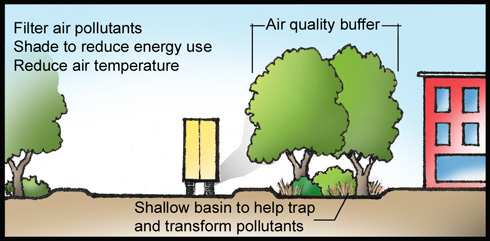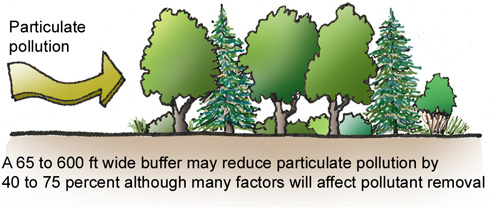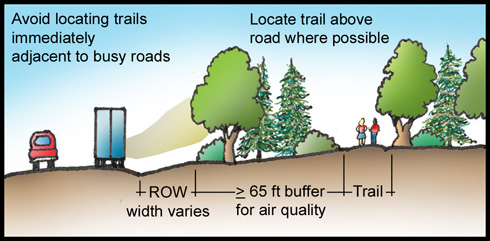GUIDELINES / 6.0 Aesthetics & Visual Quality
6.3 Air Quality Buffers

Vegetation in buffers can affect local and regional air quality in three main ways: temperature reduction, removal of air pollutants, and energy effects on buildings.
Temperature reduction: Lower air temperature due to trees and other vegetation can reduce emissions of many temperature-dependent pollutants.
Removal of air pollutants: Plants remove air pollutants by uptake via leaves and by intercepting airborne particles. Pollutants captured by vegetation are often transferred to the soil. While soils and plants will render some pollutants nontoxic, the final destination, form, and impact of the pollutants should be considered.
Energy effects on buildings. Trees reduce building energy use, lowering pollutant emissions from power plants.

Key Design Considerations
- Consider meteorological, topographical, and other landscape-scale factors in locating buffers (e.g., timing of pollution, high concentration spots).
- Plant buffers around and close to air pollution sources.
- Moderately dense buffers are best for pollutant removal.
- Use trees, shrubs, and grasses for multi-level trapping.
- Plant buffers in energy conserving locations (see 4.7 to 4.8).

Plant Selection Criteria for Air Pollutant Removal
- Evergreen trees can remove more pollutants however many conifer species are sensitive to common pollutants.
- Select plants with dense branching and twig structure.
- Leaves with hairy, resinous, and coarse surfaces capture more particles than smooth leaves. Smaller leaves are generally more efficient collectors than larger leaves.
- Herbaceous species may adsorb more gaseous pollutants.
- Use multiple species to minimize risks with low diversity.
- Use long-lived species that require minimal maintenance.
- Select species with pest and disease resistance.
- Select species suitable for the site (e.g., urban environments often have compacted and droughty soils).
